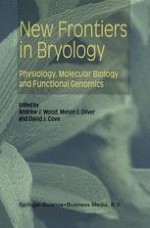2004 | OriginalPaper | Buchkapitel
Applied Genomics in Physcomitrella
verfasst von : Hauke Holtorf, Wolfgang Frank, Ralf Reski
Erschienen in: New Frontiers in Bryology
Verlag: Springer Netherlands
Enthalten in: Professional Book Archive
Aktivieren Sie unsere intelligente Suche, um passende Fachinhalte oder Patente zu finden.
Wählen Sie Textabschnitte aus um mit Künstlicher Intelligenz passenden Patente zu finden. powered by
Markieren Sie Textabschnitte, um KI-gestützt weitere passende Inhalte zu finden. powered by
The moss Physcomitrella patens, which has become a versatile tool for plant reverse genetics, has been chosen for a large scale forward genetics mutagenesis approach to address gene function at a genome wide scale. Based on the high frequency of homologous recombination found in Physcomitrella targeted knockout approaches of single genes have lead to new insights into the mode of action of plant genes. Besides a targeted knockout approach of around 80 target genes which are of commercial interest we have developed a transposon-mediated mutagenesis platform to mutagenize cDNA libraries derived from different developmental stages of the Physcomitrella life cycle. These mutagenized cDNAs are transformed into Physcomitrella protoplasts to generate about 80.000 transgenic Physcomitrella lines. The mutagenized cDNAs are supposed to integrate into the nuclear DNA at their corresponding loci thereby disrupting the underlying gene. The basis for our experimental approach was the generation of a comprehensive EST database was build from 110.000 single cDNA sequences. To realize the generation of a saturated Physcomitrella mutant collection we have also adapted the production of moss material and the transformation protocols to comply with the requirements of a high-throughput mutagenesis approach. The derived transgenic plants were subjected to PCR-based molecular analysis to confirm stable integration of the selectable marker cassette. Furthermore, all transgenic lines were investigated in terms of their nuclear DNA content to detect doubling of the chcromosomal DNA that may have been occurred during the transformation procedure. Each mutant plant was also subjected to a detailed analysis with respect to its physiological, morphological and metabolic traits. The frequency of altered phenotypes in the Physcomitrella mutant collection was considerably higher than the reported rate in Arabidopsis. Within this chapter we outline the complete procedure of the generation of the Physcomitrella mutant collection and their initial characterization.
